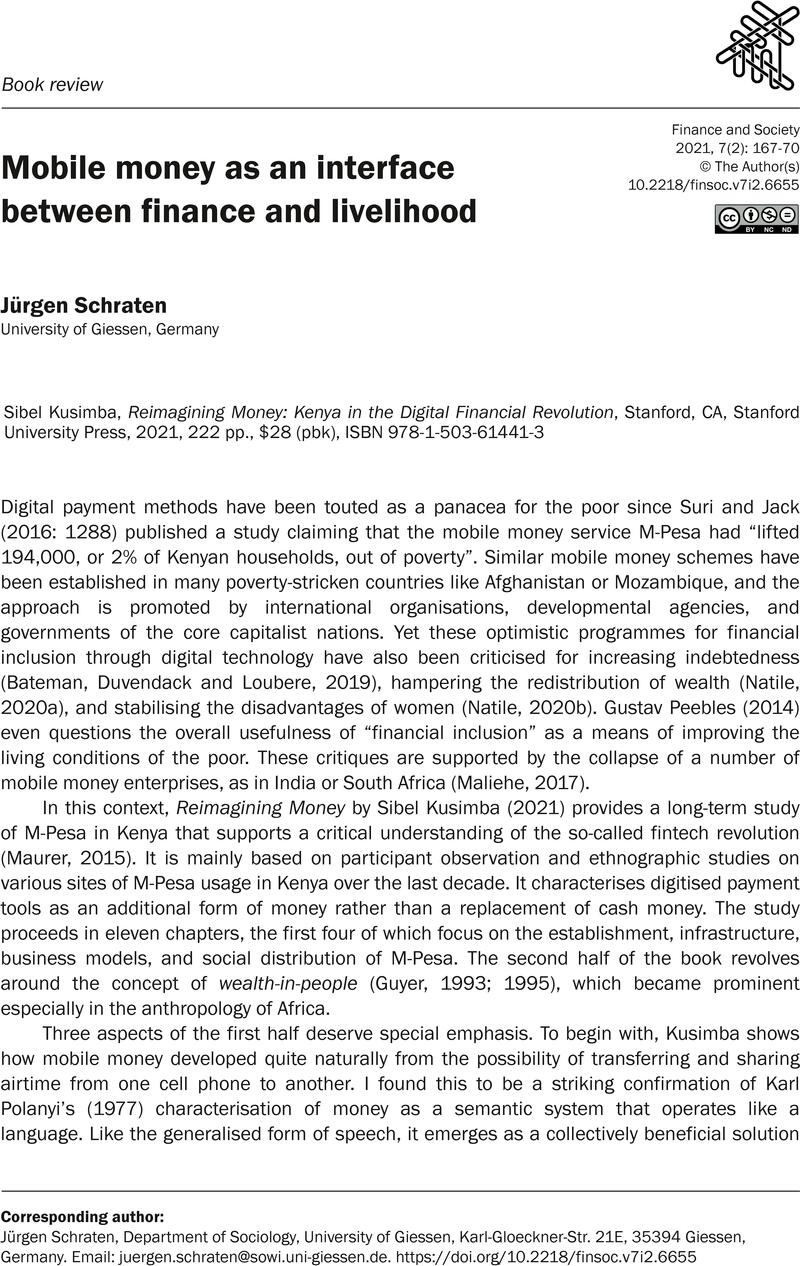No CrossRef data available.
Article contents
Mobile money as an interface between finance and livelihood - Sibel Kusimba, Reimagining Money: Kenya in the Digital Financial Revolution, Stanford, CA, Stanford University Press, 2021, 222 pp., $28 (pbk), ISBN 978-1-503-61441-3
Review products
Sibel Kusimba, Reimagining Money: Kenya in the Digital Financial Revolution, Stanford, CA, Stanford University Press, 2021, 222 pp., $28 (pbk), ISBN 978-1-503-61441-3
Published online by Cambridge University Press: 09 November 2023
Abstract
An abstract is not available for this content so a preview has been provided. As you have access to this content, a full PDF is available via the ‘Save PDF’ action button.

- Type
- Book review
- Information
- Creative Commons
- This is an Open Access article, distributed under the terms of the Creative Commons Attribution-NonCommercial-No Derivatives licence (http://creativecommons.org/licenses/by-nc-nd/4.0/), which permits noncommercial re-use, distribution, and reproduction in any medium, provided the original work is unaltered and is properly cited. The written permission of Cambridge University Press must be obtained for commercial re-use or in order to create a derivative work.
- Copyright
- © 2021 The Author(s)
References
Bateman, M., Duvendack, M. and Loubere, N. (2019) Kenya's mobile money revolution. Africa Is A Country, 29 October. Available at: <https://africasacountry.com/2019/10/kenyas-mobile-money-revolution>. Accessed 21 June 2021.. Accessed 21 June 2021.' href=https://scholar.google.com/scholar?q=Bateman,+M.,+Duvendack,+M.+and+Loubere,+N.+(2019)+Kenya's+mobile+money+revolution.+Africa+Is+A+Country,+29+October.+Available+at:+.+Accessed+21+June+2021.>Google Scholar
Ekejiuba, F.I. (1995) Down to fundamentals: Women-centered hearth-holds in rural West Africa. In: Bryceson, D.F. (ed.) Women Wielding the Hoe. New York: Berg, 47–61.Google Scholar
Guyer, J. (1993) Wealth in people and self-realization in Equatorial Africa. Man, 28(2): 243–65.CrossRefGoogle Scholar
Guyer, J. (1995) Wealth in people and wealth in things. Journal of African History, 36(1): 83–90.CrossRefGoogle Scholar
Maliehe, S. (2017) A human economy and mobile money in Africa: Lessons from South Africa. CODESRIA Bulletin, 3/4: 14–21.Google Scholar
Maurer, B. (2015) How Would You Like to Pay? How Technology is Changing the Future of Money. Durham, NC: Duke University Press.Google Scholar
Natile, S. (2020a) Digital finance inclusion and the mobile money social enterprise: A socio-legal critique of M-Pesa in Kenya. Historical Social Research, 45(3): 73–94.Google Scholar
Natile, S. (2020b) The Exclusionary Politics of Digital Financial Inclusion. London: Routledge.CrossRefGoogle Scholar
Peebles, G. (2014) Rehabilitating the hoard: The social dynamics of unbanking in Africa and beyond. Africa, 84(4): 595–613.CrossRefGoogle Scholar
Polanyi, K. (1977) Money objects and money uses. In: The Livelihood of Man. New York: Academic Press, 97–121.Google Scholar
Schraten, J. (2020) Credit and Debt in an Unequal Society. Establishing a Consumer Credit Market in South Africa. Oxford: Berghahn Books.CrossRefGoogle Scholar
Suri, T. and Jack, W. (2016) The long-run poverty and gender impacts of mobile money. Science, 354(6317): 1288–92.CrossRefGoogle ScholarPubMed




